| Potentially
Hazardous Asteroids (PHAs)
are space rocks larger than approximately 100m that can come closer to
Earth than 0.05 AU. None of the known PHAs is on a collision course
with our planet, although astronomers are finding
new ones
all the time.
On February 25, 2009 there were
1029
potentially hazardous asteroids.
Feb. 2009 Earth-asteroid
encounters:
Notes: LD
means "Lunar Distance." 1 LD = 384,401 km, the
distance between Earth and the Moon. 1 LD also
equals 0.00256 AU. MAG is the visual magnitude of
the asteroid on the date of closest approach. |
 |
 |
2-28-09 - No sunspots today
Current conditions
Solar wind
speed: 535.5 km/sec
density: 1.1 protons/cm3
explanation |
more
data
Updated: Today at 1126
UT
X-ray Solar Flares
6-hr max: A0 1125
UT Feb28
24-hr: A0 1125 UT
Feb28
explanation |
more data
Updated: Today at: 1125
UT
SATELLITE DEBRIS:
US Strategic Command is still cataloguing
debris from the Feb. 10th
satellite collision over northern Siberia. "The count is now
at 109 catalogued fragments for Iridium 33 and 245 for Kosmos
2251," says satellite observer Daniel Deak, who has prepared some
3D maps of the debris for readers of spaceweather.com
similar image shows Iridium 33 debris, and other views
are available, too:
#1,
#2,
#3,
#4,
#5.These maps reveal in full what earlier, less
complete maps strongly hinted: Kosmos debris is scattered
more widely than Iridium. "Kosmos fragments range in
altitude from 250 km to 1690 km," says Deak. For
comparison, "Iridium fragments range only from 525 km to
1092 km." Kosmos fragments descend all the way down to the
350 km orbit of the ISS. The space station is in little
danger, however; most of the Kosmos scatter is over the
Antarctic where the ISS does not go.
The fragment count now stands at 354. Says Deak, "there
are surely more to come."
FEB 28th UPDATE: Since these
maps were posted on Feb. 26th, the catalogued fragment
count has jumped from 354 to 414.
COMET
TAILS: Have you been wondering
why Comet Lulin has two tails--and why one of them
disappeared on Feb. 24th just as the comet was passing
Earth? Science popularizer
Borja Tosar
of Spain has created a series of diagrams to answer
these questions. Click on this image to begin:
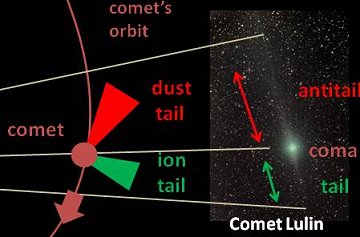
View the complete set:
:
#1,
#2,
#3,
#4,
#5.
The nucleus of Comet Lulin spews a mixture of dust
and gas into space. Quickly, the mixture separates
into two distinct tails: The gaseous "ion tail" is
pushed straight away from the sun by solar wind. The
weightier dust tail resists solar wind pressure and
aligns itself more or less with the comet's orbit.
The next image shows
why the ion tail disappeared: It is temporarily
hidden behind the comet's head. And finally we see
Tosar's
prediction for the future: The ion tail will
re-appear during the early days of March. The two
tails, ion and dust, and sometimes called
the tail and the antitail.
UPDATED:
Comet Lulin Photo Gallery
[Comet
Hunter Telescope] [Sky maps:
Feb. 27,
28]
Geomagnetic Storms have
increased a little.:
Probabilities for
significant disturbances in Earth's magnetic field are given for
three activity levels:
active,
minor
storm,
severe
storm
Updated at: 2009 Feb 27 2201
UTC
Mid-latitudes
|
|
0-24 hr
|
24-48 hr
|
|
ACTIVE
|
05 %
|
05 %
|
|
MINOR
|
01 %
|
01 %
|
|
SEVERE
|
01 %
|
01 %
|
High latitudes
|
|
0-24 hr
|
24-48 hr
|
|
ACTIVE
|
10 %
|
10 %
|
|
MINOR
|
01 %
|
01 %
|
|
SEVERE
|
01 %
|
01 %
|
|
|
2-27-09 No sunspots today
Current conditions
Solar wind
speed: 672.9 km/sec
density: 1.5 protons/cm3
explanation |
more data
Updated: Today
at 2346 UT
X-ray Solar Flares
6-hr max: A0
2340 UT Feb27
24-hr: A2
0715 UT Feb27
explanation |
more data
Updated: Today
at: 2340 UT
|
2-26-09 sunspot 1013 is fading -
New-cycle sunspot 1013 is rapidly fading
away and will likely be gone by the end of the day. Credit: SOHO/MDI
Current conditions
Solar wind
speed: 411.5 km/sec
density: 1.6 protons/cm3
explanation |
more data
Updated: Today at 0916 UT
X-ray Solar Flares
6-hr max: A0 0910 UT
Feb26
24-hr: A0 0910 UT
Feb26
explanation |
more data
Updated: Today at: 0910 UT
OTHERWORLDLY SOLAR
ECLIPSE: For the first time, a spacecraft
from Earth has captured hi-resolution video of a solar eclipse
while orbiting another world. Get the
full story from Science@NASA.
DOOMED SATELLITE:
NASA's
Orbiting Carbon Observatory (OCO) blasted off from
California's Vandenberg Air Force Base on Feb. 24th around 1:55 in
the morning Pacific Time. An all-sky camera in nearby Santa
Barbara captured the early stages of what would prove to be a
doomed flight:
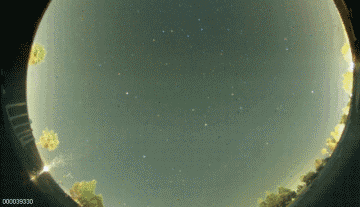
Click to view a larger movie
"We photographed the launch using an
AllSky-340C mounted on our roof," says Matt Thomas of Santa
Barbara Instrument Group. "It monitors the sky 24/7, and you can
see live images
here."
Unfortunately, OCO never made it to Earth orbit. After the
satellite left the field of view, above, it failed to separate
from its Taurus XL launch vehicle. The stuck-together pair
splashed down in the icy waters near Antarctica. Climate
scientists are calling the loss a "serious setback" in their
efforts to identify our planet's
carbon sinks
and solve the
mystery of missing carbon--the 30% of human-produced carbon
dioxide that disappears into unknown places. A
NASA panel has been convened to investigate the mishap.
COMET LULIN
UPDATE: Comet Lulin is now receding from
Earth, but observers say the comet is still bright enough to see
with the unaided eye from dark-sky sites. It looks like a faint
patch of gas near Regulus, a 1st magnitude star in Leo:
sky map.
Australian astrophotographer Joseph Brimacombe took this
picture using a remotely-controlled telescope in New Mexico on
Feb. 22nd:
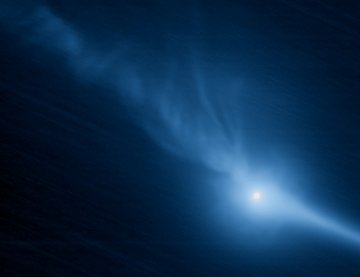
"The image is a median stack of 50 three-minute
exposures," says Brimacombe. "What an endlessly surprising
and beautiful comet Lulin has turned out to be."
Note: Yesterday we suggested that the
gaseous ion tail of Comet Lulin had been torn away by a
solar wind gust on Feb. 23rd. That may be, but another
phenomenon is at work, too. The ion tail is at least
partially hidden behind the comet's head as the comet
swings past Earth. Rapidly changing geometry will soon
bring the unruly tail back into view--if indeed it is
there.
Comet Lulin Photo Gallery
[Comet
Hunter Telescope] [Sky maps:
Feb. 27,
28]
|
|
2-25-09 - sunspot 1013 near the top of the sun
Current conditions
Solar wind
speed: 416.9 km/sec
density: 2.1 protons/cm3
explanation |
more
data
Updated: Today at
2346 UT
X-ray Solar Flares
6-hr max: A0
2340 UT Feb25
24-hr: A0
1730 UT Feb25
explanation |
more
data
Updated: Today at:
2340 UT
THE GREAT
GREEN Q-TIP: For weeks, Comet Lulin
has sported a wispy tail of electric-blue ionized gas
emerging from the comet's head like a shock of unruly
hair:
image. Today, that tail is gone:
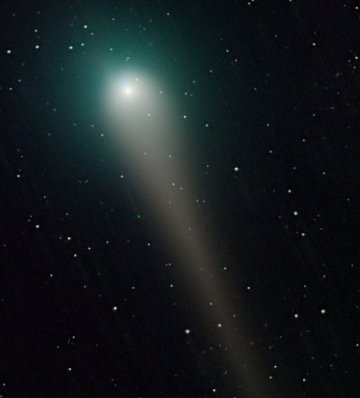
couldn't detect the ion tail even in a
deep 24-minute exposure," reports
astrophotographer John Nassr, who took the
picture on Feb. 24th from his private
observatory in the Philippines.
Comet
Lulin now resembles a great green Q-tip!
A
three-day sequence of photos by Nassr
reveals what happened: Apparently, a gust
of solar wind disrupted the comet's
gossamer ion tail. Meanwhile, the comet's
heavier, spike-shaped dust tail was not
noticeably disturbed. This has happened at
least twice before in January and
February, and each time the ion tail
rapidly grew back.
UPDATE:
A high-contrast movie of Comet Lulin
recorded on Feb. 25th by Filipe Alves of
Play it!
|
| 2-24-09 NEW
SUNSPOT: The Solar and Heliospheric Observatory
(SOHO) is
monitoring a sunspot now forming in the sun's northern hemisphere. The
spot's high latitude and magnetic polarity identify it as a member of new
Solar Cycle 24. Readers, if you have a
solar telescope, now is the time to watch sunspot genesis in action.
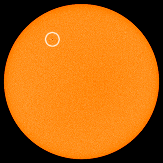
Solar wind
speed: 430.3 km/sec
density: 1.9 protons/cm3
explanation |
more
data
Updated: Today at
2345 UT
X-ray Solar Flares
6-hr max: A0
2340 UT Feb24
24-hr: A0
2340 UT Feb24
explanation |
more
data
Updated: Today at:
2340 UT
|
2-23-09 - no sunspots today
Current conditions
Solar wind
speed: 424.0 km/sec
density: 4.0 protons/cm3
explanation |
more
data
Updated: Today at
2258 UT
X-ray Solar Flares
6-hr max: A0
2340 UT Feb23
24-hr: A0
2340 UT Feb23
explanation |
more
data
Updated: Today at:
2340 UT
ONE O'CLOCK
IN THE MORNING:/tr>
2-22-09 - No sunspots today
Solar wind
speed: 431.0 km/sec
density: 4.0 protons/cm3
explanation |
more data
Updated: Today at 2337 UT
X-ray Solar Flares
6-hr max: A0 2330 UT
Feb22
24-hr: A0 0630 UT
Feb22
explanation |
more data
Updated: Today at: 2330 UT
DOOMED
SNOWBALL: on Feb. 23rd, the Solar
and Heliospheric Observatory (SOHO) watched a comet plunge
into the sun and disintegrate. The doomed snowball was a
member of the Kreutz sungrazer family. Named after a 19th
century German astronomer who studied them in detail,
Kreutz sungrazers are fragments from the breakup of a
giant comet some 2000 years ago. More than a thousand of
these fragments have been catalogued by SOHO since the
observatory was launched in 1995. Most are small and
faint, but this one was a beauty.
Watch the movie.
COSMIC
COINCIDENCE: What are the odds? On
Tuesday morning, Feb. 24th, Saturn and Comet Lulin will
converge in the constellation Leo only 2o
apart. At the same time, Comet Lulin will be making its
closest approach to Earth (38 million miles), while four
of Saturn's moons
transit the disk of the ringed planet. Oh, and the Moon
will be New, providing dark skies for anyone who wishes to see
the show. All you need now ... is
a telescope.ONE
O'CLOCK IN THE MORNING: Set
your alarm for 1 am. That's the best time to see Comet
Lulin riding high in the southern sky pleasingly close
to golden Saturn:
sky map. To the unaided eye, Lulin looks like a
faint patch of gas. Point your telescope at that patch
and you will see a lovely green comet. Conrad Pope of
Kelly, North Carolina, took this picture, a 3-minute
exposure, through his 4-inch Takahashi refractor on
Feb. 21st:
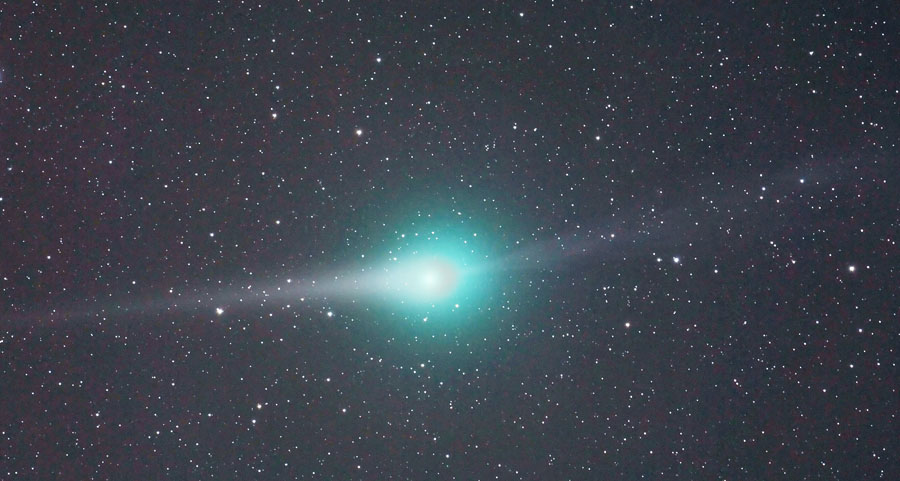
On Feb. 24th, Comet Lulin will swing past Earth
only 38 million miles away. Got clouds? No
problem. The
Coca-Cola Space Science Center in Columbus,
Georgia, plans to webcast the encounter. "We're
going to transmit the view through our
observatory's 16-inch Schmidt-Cassegrain
telescope," says astronomy professor Rosa Williams
of Columbus State University. "The webcast begins
at 11:30 EST on Monday, Feb. 23rd and will
continue until 5 a.m. EST on Tuesday the 24th."
Tune in!
UPDATE--SPEEDING COMET: "Last
night (Feb.21) Comet Lulin was visible to the
naked eye with identical brightness as star b Vigo
HP58510 with a magnitude of 5.35," reports Eddie
Irizarry of the Sociedad de Astronomía del Caribe
in Puerto Rico. "But what caught our attention
most was Lulin's noticeable speed. Using a
telescope, take a good look at the stars that
surround Comet Lulin; then look again just 10
minutes later and you will see how Lulin's
position has changed. It is amazing how fast this
comet is moving!"
Comet Lulin Photo Gallery
[Comet
Hunter Telescope] [Sky maps:
Feb. 22,
23,
24,
25]
|
2-21-09 - no sunspots today
Solar wind
speed: 450.6 km/sec
density: 7.0 protons/cm3
explanation |
more
data
Updated: Today at
2346 UT
X-ray Solar Flares
6-hr max: A0
2340 UT Feb21
24-hr: A0
2340 UT Feb21
explanation |
more
data
Updated: Today at:
2340 UT
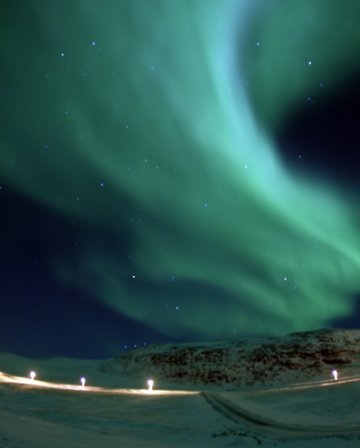
The solar wind stream that triggered this display came from a
coronal hole--a magnetic "weak spot" in the sun's atmosphere that
allows solar wind to escape into the solar system. The next
coronal hole won't turn to face Earth for at least a week, which
means Arctic auroras will probably subside until the early days of
March. Until then, browse the gallery:
Comet Lulin's vivid green atmosphere is about
three times as wide as the planet Jupiter, and its
dusty tail stretches more than 1.5 million km into
space. The comet is so big that "it no longer
completely fits in my telescope's field of view,"
says Newton.
SPEEDING COMET:
"On Feb. 21st, Comet Lulin was visible to the naked eye
with identical brightness as star b Vigo HP58510 with a
magnitude of 5.35," reports Eddie Irizarry of the Sociedad
de Astronomía del Caribe in Puerto Rico. "But what caught
our attention most was Lulin's noticeable speed. Using a
telescope, take a good look at the stars that surround
Comet Lulin; then look again just 10 minutes later and you
will see how Lulin's position has changed. It is amazing
how fast this comet is moving!"
UPDATED:
February 2009 Aurora Gallery
[Previous Februaries:
2008,
2007,
2006,
2004,
2003,
2002]
|
2-20-09 There are no sunspots today. Current conditions
Solar wind
speed: 330.8 km/sec
density: 5.9 protons/cm3
explanation |
more data
Updated: Today at 1355 UT
X-ray Solar Flares
6-hr max: A0 1355 UT
Feb20
24-hr: A0 0255 UT
Feb20
explanation |
more data
Updated: Today at: 1355 UT
GRAND CENTRAL STATION:
On Feb. 17th and 18th, many observers of Comet
Lulin saw something unexpected. In addition to the comet, "I kept getting
satellite trails in my images," reports
John Cordiale of Queensbury,
New York. "It was like Grand Central Station. Multiple groupings of
satellites traveled through my images for hours." He photographed the
activity using a 2.5-inch (65mm) refractor:
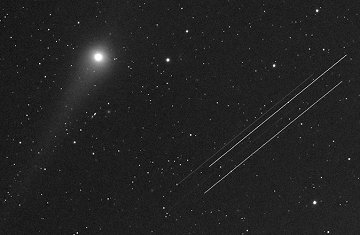
"It made me
wonder if I was seeing debris from the recent double
satellite collision," says Cordiale.
It certainly looked like flying debris (see
this animation from Jesus Pelaez of Padilla de Arriba, Spain).
But no, what Cordiale, Pelaez and others saw was actually a band
of intact geostationary satellites.
Geostationary satellites orbit Earth twenty-two thousand miles
above the equator, always keeping station above a single point on
the ground. While geosats are stationary with respect to Earth's
surface, they move with respect to the stars. Viewed through the
eyepiece of a star-tracking telescope, the stars are motionless
while the "stationary" satellites streak through the field of view
like so much debris. Strange but true.
From mid-Northern latitudes, geostationary satellites occupy a
band of declinations between approximately -5 and -7 degrees. By
happenstance, Comet Lulin passed through that band on Feb. 17th
and 18th, setting the stage for an unexpected show. "I had never
seen anything like it!" says Cordiale.
Comet Lulin is
approaching Earth for a 38-million-mile close encounter on Feb. 24th.
At that time, the comet could shine two or three times brighter than it
does now, and photographers will record it using cameras alone--no
telescope required. Browse the gallery for a hint of things to come
Comet Lulin Photo Gallery
[Comet
Hunter Telescope] [Sky maps:
Feb. 18,
19,
20]
The first gamma-ray burst to be seen in high
resolution from NASA's Fermi Gamma-ray Space
Telescope is one for the books. The blast had
the greatest total energy, the fastest motions and
the highest-energy initial emissions ever seen.
"We were waiting for this one,"
said Peter Michelson, the principal investigator on
Fermi's Large Area Telescope at Stanford University.
"Burst emissions at these energies are still poorly
understood, and Fermi is giving us the tools to
understand them."
|
2-19-09 - There are no sunspots today
Solar wind
speed: 332.5 km/sec
density: 11.4 protons/cm3
explanation |
more
data
Updated: Today at
2344 UT
X-ray Solar Flares
6-hr max: A0
2340 UT Feb19
24-hr: A0
2340 UT Feb19
explanation |
more
data
Updated: Today at:
2340 UT
|
2-18-09 - There are no sunspots today Current conditions
Solar wind
speed: 304.3 km/sec
density: 5.0 protons/cm3
explanation |
more
data
Updated: Today at
2346 UT
X-ray Solar Flares
6-hr max: A0
2340 UT Feb18
24-hr: A0
1020 UT Feb18
explanation |
more
data
Updated: Today at:
2340 UT
SPACECRAFT
BUZZES MARS: NASA's
Dawn spacecraft had a
close encounter with Mars last night,
flying just 341 miles
above the Red Planet's surface. The gravity-assist maneuver
propelled Dawn
toward the asteroid belt where it will orbit
and explore
Vesta
and Ceres beginning in 2011. Mission
managers say the Mars
flyby images will be beamed back to Earth on or about Feb.
24th.
|
2-17-09 - No sunspots today
Current conditions
Solar wind
speed: 359.2 km/sec
density: 4.5 protons/cm3
explanation |
more
data
Updated: Today at
2345 UT
X-ray Solar Flares
6-hr max: A0
2340 UT Feb17
24-hr: A0
2340 UT Feb17
explanation |
more
data
Updated: Today at:
2340 UT
|
2-16-09 - No sunspots today
Solar wind
speed: 516.2 km/sec
density: 1.1 protons/cm3
explanation |
more data
Updated: Today at 0155 UT
X-ray Solar Flares
6-hr max: A0 2355 UT
Feb15
24-hr: A0 2355 UT
Feb15
explanation |
more data
Updated: Today at: 2355 UT
MULTIPLE FIREBALLS:
On Friday, Feb. 13th, around 10:00 pm EST,
people in central Kentucky heard loud booms, felt their houses shake,
and some saw a fireball streaking through the sky:
eye-witness reports. On Sunday, Feb. 15th, around 11 am CST, an
even brighter fireball appeared over central Texas in broad
daylight. News outlets and even the National Weather Service are
attributing these events to re-entering debris from the recent
satellite collision between Iridium 33 and Kosmos 2251. Skepticism
is warranted. Evidence reported so far does not rule out a meteoritic
origin; these fireballs could be a result of garden-variety space
rocks hitting Earth, as they do almost every day. Until, e.g., US
Strategic Command issues a statement linking the fireballs to
radar-tracked satellite debris, it's best to keep an open mind
http://www.comcast.net/data/fan/html/popup.html?v=1035970889
Stragetic Air Command refuses to say anything about the fireball that
caused this fire in Texas.
|
2-15-09 - No sunspots today
Current conditions
Solar wind
speed: 524.1 km/sec
density: 0.9 protons/cm3
explanation |
more
data
Updated: Today at
2345 UT
X-ray Solar Flares
6-hr max: A0
2340 UT Feb15
24-hr: A0
2340 UT Feb15
explanation |
more
data
Updated: Today at:
2340 UT
|
2-14-09 Sunspot 1012 is moving across the face of the sun
Current conditions
Solar wind
speed: 486.7 km/sec
density: 7.6 protons/cm3
explanation |
more data
Updated: Today at 1315 UT
X-ray Solar Flares
6-hr max: A0 1315 UT
Feb14
24-hr: A0 1315 UT
Feb14
explanation |
more data
Updated: Today at: 1315 UT
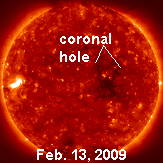
Solar wind stream flowing from
the
indicated coronal hole should reach
Earth on Feb. 14th or
15th.
Credit: Hinode X-ray Telescope
|
2-13-09 - Emerging sunspot
1012 is a member of old Solar Cycle 23.
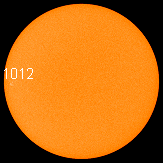
Credit: SOHO/MDI
SOLAR ACTIVITY:
Sunspot 1012 is crackling with
B-class solar flares. Yesterday, Feb. 12th at 1625 UT, one
such eruption propelled a "solar
tsunami" through the sun's lower atmosphere. An ultraviolet
telescope onboard NASA's STEREO-B spacecraft recorded the faint
yet powerful wave:
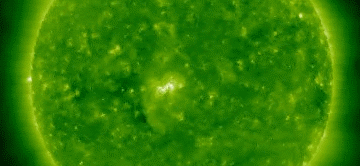
The low latitude and magnetic polarity of this
sunspot identify it as a member of old Solar Cycle 23. It is, in
other words, a fossil, albeit a relatively active one. Stay tuned
for more flares.
Explore the Sunspot Cycle
NOAA Space Weather
Prediction Center
Solar wind
speed: 299.5 km/sec
density: 4.5 protons/cm3
explanation |
more data
Updated: Today at 1436 UT
X-ray Solar Flares
6-hr max: A0 0850 UT
Feb13
24-hr: B2 0545 UT
Feb13
explanation |
more data
Updated: Today at: 1430 UT
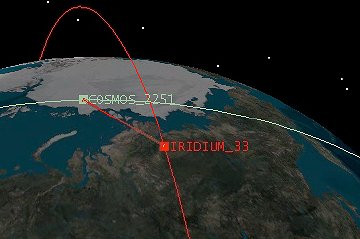
Click to view a 2.3 MB animation
COLLIDING SATELLITES: Experts are calling it an "unprecedented
event." Two large satellites have collided in Earth orbit. Kosmos 2251
crashed into Iridium 33 on Tuesday, Feb. 10th, approximately 800 km over
northern Siberia; both were destroyed. The resulting clouds of debris
contain more than 500 fragments, significantly increasing the orbital
debris population at altitudes where the collision occurred. The Air
Force Space Surveillance Radar is monitoring the clouds as they pass over
the radar facility in Texas. We, in turn, are monitoring signals from the
radar and you may be able to hear debris "pings" by tuning in to our live
audio feed. This is a story that will unfold in the days ahead as
researchers study the evolution of the debris clouds and piece together
the details of the collision.
U.S.
Strategic Command is tracking hundreds of satellite fragments. In
the 48+ hours since the collision, the debris swarm has spread
around both orbits. Experts characterize the distribution as a
pair of "clumpy rings"; one ring traces the orbit of Iridium 33,
the other traces the orbit of Kosmos 2251.This injection of
debris substantially increases the population of space junk at
altitudes near 800 km. Collisions are now more likely than ever.
Fortunately, the International Space Station orbits Earth at a
much lower altitude, 350 km, so it is in no immediate danger. The
Hubble Space Telescope is not so safe at 610 km. In the days
ahead, researchers will carefully study the make-up and dynamics
of the debris cloud to estimate when bits will begin to drift down
to lower altitudes.
LISTEN UP: The US
Air Force Space Surveillance Radar is monitoring the skies above
Texas for echoes from satellite fragments.
Try listening on
Friday, Feb. 13th between 11:12 and 11:21 CST
(1712 - 1721 UT). That's when Iridium 33 would have passed over
the radar intact had it not been shattered.
NOTE: Other sources are saying this was a deliberate attack by
Russia on the United States.
Debris From Space Collision Poses Threat to Other
Satellites
By
Tariq Malik
Senior Editor
posted: 12 February 2009
10:17 am ET
|
Scientists at NASA are keeping close tabs on two clouds
of debris from Tuesday collision between U.S. and
Russian satellites to determine how much of a risk they
pose to the agency's Earth-watching spacecraft and,
possibly, the Hubble Space Telescope.
The
rare collision between a U.S. Iridium 33
communications satellite and the defunct Russian
military communications satellite Cosmos 2251 is
unprecedented, marking the first time two intact
satellites orbiting Earth have accidentally crashed into
and obliterated one another, NASA officials said. Their
smash-up created two
large clouds of space debris that are currently
being tracked by the U.S. Space Surveillance Network.
The debris poses a greater risk to science satellites
than
to the International Space Station, which is
currently home to two American astronauts and a Russian
cosmonaut,
since the collision occurred 490 miles (790 km)
above Siberia. The space station flies in an orbit about
220 miles (354 km) above Earth.
"This is like over 400 kilometers above the station, so
we do believe that some of the debris is going down
through station altitude. But it's a very, very small
minority of the debris clouds," said Nicholas Johnson,
chief scientist of NASA's Orbital Debris Program Office
at the Johnson Space Center in Houston. "For robotic
spacecraft at higher altitudes, the answer's a little
bit different. So one by one we'll be looking at those."
Earth observations satellites, such as NASA's Aqua and
Aura spacecraft in orbit 438 miles (705 km) above Earth,
are particularly vulnerable - though the risk of an
impact is still low - and there's another satellite in a
497-mile (800-km) orbit just above the impact level,
Johnson told SPACE.com late Wednesday. The Hubble
Space Telescope orbits the Earth at about 372 miles (600
km), Johnson said.
"That's a little bit farther away, but it's a lot bigger
too. All that matters," Johnson said of Hubble. "It's
about how close you are to the debris cloud and how big
you are."
It will be weeks before the U.S. Space Surveillance
Network pins down an accurate count of the number of
individual debris pieces created in the event, but
unofficial estimates put the damage somewhere in the 500
count. The U.S. Space Surveillance Network is currently
tracking more than 18,000 separate man-made objects and
debris at any given time, officials with the U.S.
Strategic Command said Wednesday.
"This is the first time we've had two intact spacecraft
collide, so it is a big deal," Johnson said. "But you
know, it's not unexpected."
Johnson said that some satellites fly within a few
hundred meters of each other every day. Each year, there
are about six instances in which old satellites and
satellite parts break apart in what scientists call "fragmentation
events." Satellite components or spent rocket stages
have accidentally collided three times before in the
last 20 years.
In June 1997, an unmanned Russian Progress cargo ship
slammed into Russia's Mir Space Station, damaging a
solar array and radiator, and punching a hole in the
ship's hull that depressurized one of its modules.
Unlike Tuesday's collision, that Progress spacecraft was
deliberately heading for Mir, where it was expected to
dock in a rendezvous system test.
"This was going to happen," Johnson said of Tuesday's
accidental collision. "There was no doubt that it was
going to happen."
Johnson said the chances of a satellite being damaged by
the debris from Tuesday's collision are admittedly low,
but as the collision itself proved, such things can
happen. He does not expect to see reports of many
secondary impacts from the event.
He pointed out that when China intentionally destroyed
one of its aging weather satellites during a
2007 anti-satellite test, the impact created a cloud
of more 2,500 pieces of debris.
"We don't know if any of them have hit any other
satellite, alive or dead," Johnson said of the Chinese
test debris. "So the odds are still very small, but
they're bigger today than they were two days ago."
Fireball may be from two
satellites
05:56
PM CST on Sunday, February 15,
2009
KVUE
News
Debris from two satellites
fell over Central Texas on Sunday.
Numerous people in Austin reported
seeing a fireball in the sky
before plummeting to Earth.
I n
addition to
Austin, the
fireball was
seen in
Houston and
as far north
as Plano.
Residents
from Marlin
to Corsicana
reported
feeling
"explosions"
as debris
from two
satellites
that had
crashed last
week began
entering
Earth's
atmosphere.
So far, no
debris has
been found.
Reports
began coming
into the
KVUE
Newsroom
around 11
a.m. Many
reported
seeing the
fireball to
the north
and west of
Austin.
Callers said
the fireball
lasted just
several
seconds
before
disappearing.
There
were initial
reports that
a plane may
have gone
down in
Williamson
County.
Emergency
crews
searched the
area around
Liberty and
Leander for
about 45
minutes, but
did not find
anything.
The
Federal
Aviation
Administration
in Austin
did not
believe it
was a plane
crash. They
said all of
their planes
had been
accounted
for.
If you
have any
pictures or
video of the
fireball
seen of
Central
Texas skies,
please send
them to
news@kvue.com
|
|
|
|
There were 2 MAJOR breeches in the
magnetosphere last evening. The first one shut down
http://www2.nict.go.jp/y/y223/simulation/realtime/ for 3 hours,
with a proton blast that went off the charts to about 4.5. That
one started at 00UTC which is 5 pm MST.
The second started about 11 or so and protons went a bit over 40.
You can see this on the BOTTOM proton chart (p/cc's) on the above
webpage. These are very different from the geomagnetic storms we
have been receiving recently and a sign of great change about to
manifest. I suggest if these sheep were felling the 2nd breach,
based on the time you gave, also based on where you live, seems
like PST?
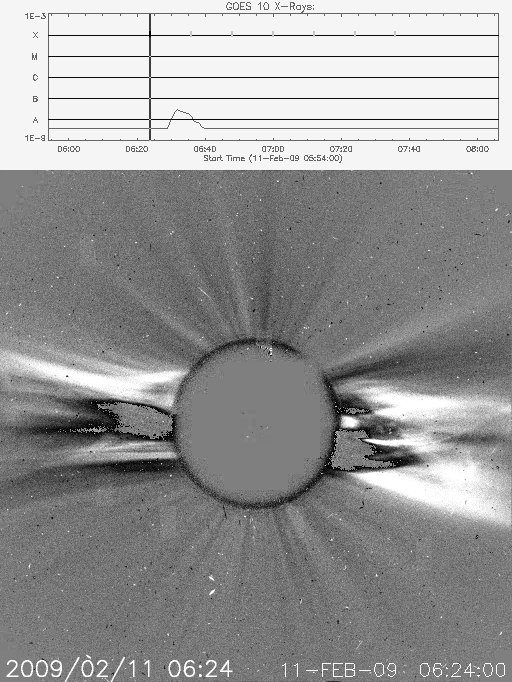
http://www.lmsal.com/solarsoft/latest_events_summary/gev_20090211_0629/gev_20090211_0629_laslm.html
|
|
|
SOLAR FLARE:,
Feb. 10th at 2310 UT, Earth-orbiting satellites detected a
B1-class solar flare. Normally, such a small eruption would
pass unremarked, but during this deep solar minimum, it's a
relatively big event. NASA's STEREO-B spacecraft photographed the
probable blast-site shortly before and after the eruption:
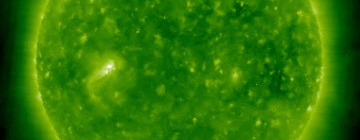
Image credit: STEREO-B Extreme
Ultraviolet Telescope [larger
image]
The source of the explosion appears to be a collapsing (or
erupting) magnetic filament. The filament was present before the
flare, absent afterward. Higher-cadence imagery from the Solar and
Heliospheric Observatory (SOHO) may confirm or refute this idea;
however, those images have not yet been beamed back to Earth. |
|
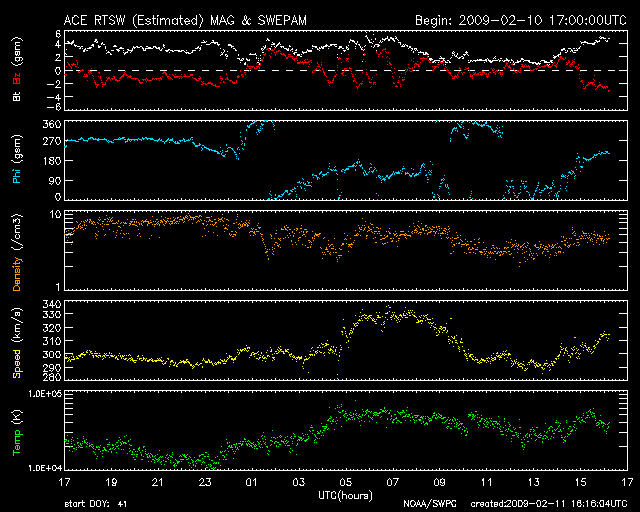
|
2-11-09 No sunspots today
Current conditions
Solar wind
speed: 300.9 km/sec
density: 4.6 protons/cm3
explanation |
more data
Updated: Today at 0405 UT
X-ray Solar Flares
6-hr max: B1 2310 UT
Feb10
24-hr: B1 2310 UT
Feb10
explanation |
more data
Updated: Today at: 2355 UT
|
2-10-09 - No sunspots today
Current conditions
Solar wind
speed: 295.3 km/sec
density: 8.8 protons/cm3
explanation |
more data
Updated: Today at 2345 UT
X-ray Solar Flares
6-hr max: B1 2310 UT
Feb10
24-hr: B1 2310 UT
Feb10
explanation |
more data
Updated: Today at: 2340 UT
|
2-9-09 - No sunspots today
Current conditions
Solar wind
speed: 285.9 km/sec
density: 2.6 protons/cm3
explanation |
more data
Updated: Today at 2346 UT
X-ray Solar Flares
6-hr max: A0 2340 UT
Feb09
24-hr: A0 0220 UT
Feb09
explanation |
more data
Updated: Today at: 2340 UT
COMET LULIN
UPDATE: Experienced observers report
that
Comet Lulin has brightened to naked-eye visibility from
dark-sky sites. It looks like a pale "fuzzy patch" in the
constellation Libra before dawn. Backyard telescopes pointed
at the patch reveal a lovely green comet with a rapidly
re-growing plasma tail. Browse
the gallery for latest photos.
Feb 24th is special for another reason: Comet Lulin
makes its closest approach to Earth on that date,
coincidentally just a few degrees away from Saturn:
sky map. In one quick sweep of a backyard
telescope, you'll be able to see Titan, Saturn's
edge-on rings, and a
green comet with an
active tail. Mark your calendar!
SUBTLE LUNAR
ECLIPSE: Earlier today, the full
Moon passed through
the outskirts
of Earth's shadow producing a subtle "penumbral" lunar
eclipse. Christopher Calubaquib photographed the event
from El Sobrante, California:
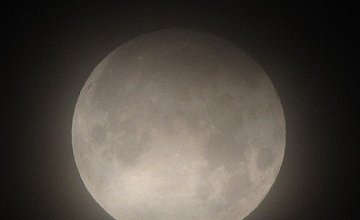
Normal full Moons are fully lit, yet this one has a
dusky shading across the north pole. That was the
eclipse.
"It was not really a sight that would stop someone in
their tracks, but I did find it to be much darker than I
imagined," reports Navneeth Chandrasekaran from Chennai,
Tamilnadu, India. "This
photo was taken about 10 minutes before maximum
eclipse."
more images:
from Pam Haley of Kailua, Hawaii;
from Yandong Hu of Changzhou, Jiangsu, China;
from Wah! of Hong Kong;
from Miyagi Takafumi of Okinawa Japan;
from Karzaman Ahmad of Langkawi National Observatory,
Malaysia;
from Andy Yeung of Hong Kong;
from Rob Kaufman of Bright, Victoria, Australia;
from Grahame Kelaher of Perth, Australia;
from Ben Levis of Carmel, Perth, Western Australia;
|
2-8-09 No sunspots today
Current conditions
Solar wind
speed: 320.1 km/sec
density: 4.2 protons/cm3
explanation |
more data
Updated: Today at 2345 UT
X-ray Solar Flares
6-hr max: A0 2340 UT
Feb08
24-hr: A0 2340 UT
Feb08
explanation |
more data
Updated: Today at: 2340 UT
|
2-7-09 No sunspots today
Current conditions
Solar wind
speed: 304.8 km/sec
density: 4.3 protons/cm3
explanation |
more data
Updated: Today at 2343 UT
X-ray Solar Flares
6-hr max: A0 2340 UT
Feb07
24-hr: A0 2340 UT
Feb07
explanation |
more data
Updated: Today at: 2340 UT
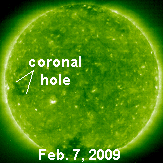
A solar wind stream flowing from the
indicated coronal hole should reach Earth on Feb. 13th or 14th. Credit:
SOHO Extreme UV Telescope
VALENTINE'S SHOW?
Arctic sweethearts, take note. A solar wind stream is heading
toward Earth and it might spark high-latitude auroras when it
arrives on Feb. 14th. Valentine's Day could end with a sweet
display of Northern Lights:
gallery.
NAKED-EYE COMET:
Comet Lulin is now visible to the naked eye from dark-sky
sites. "This morning, I noticed a faint smudge above
Zubenelgenubi," reports Jeff Barton from the Comanche
Springs Astronomy Campus in West Texas. "I then trained my
9x63 binoculars on the fuzzy patch. Yep, nailed it! I was
thrilled to finally bag Comet Lulin without optical aid."
If optical aid is
offered, however, don't refuse it. The view through a
small telescope is dynamite:
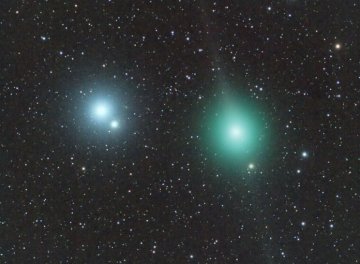
"Wow, it was nice!" says photographer Mike Broussard of
Maurice, Louisiana, who took this picture of Comet Lulin
gliding by double star Zubenelgenubi on Feb. 6th.
Another report of naked-eye visibility comes from Martin
McKenna of Maghera, Northern Ireland: "I went out for a look
at Comet Lulin this morning before dawn with my telescope and
binoculars. The Moon was very low, so I stood within the
shadow of my house and tried to see the comet without optical
aid. Using averted vision, I was able to glimpse the comet
perhaps a dozen times! It looked like a large grey patch of
light very close to Zubenelgenubi. The sight gave me a warm
glow on such a frigid frosty night."
Comet Lulin rises in the east just a few hours before the
sun. See for yourself:
sky map.
UPDATED:
Comet Lulin Photo Gallery
[Comet
Hunter Telescope] [sky
map] [ephemeris]
|
2-6-09 No sunspots today
Current conditions
Solar wind
speed: 319.6 km/sec
density: 4.9 protons/cm3
explanation |
more data
Updated: Today at 2346 UT
X-ray Solar Flares
6-hr max: A0 2340 UT
Feb06
24-hr: A0 2340 UT
Feb06
explanation |
more data
Updated: Today at: 2340 UT
|
2-5-09 - No sunspots todayCurrent conditions
Solar wind
speed: 358.8 km/sec
density: 6.2 protons/cm3
explanation |
more data
Updated: Today at 1456 UT
X-ray Solar Flares
6-hr max: A0 1445 UT
Feb05
24-hr: A0 1445 UT
Feb05
explanation |
more data
Updated: Today at: 1445 UT
CLOSE ENCOUNTER:
Comet Lulin is having a close encounter with
Zubenelgenubi, a naked-eye double star in the
constellation Libra. Zubenelgenubi is not only fun to say (zuBEN-el-JA-newbee),
but also a handy guide to the comet. Point your binoculars at
the star and voilà!--Lulin materializes in the field of view.
The best time to look is just before dawn on Friday, Feb 6th:
sky map.
DISCONNECTED TAIL: On Feb. 4th,
a team of Italian astronomers witnessed "an intriguing
phenomenon in Comet Lulin's tail." Team leader Ernesto
Guido explains: "We photographed the comet using a
remotely-controlled telescope in New Mexico, and our
images clearly showed a disconnection event. While we
were looking, part of the comet's plasma tail was torn
away."
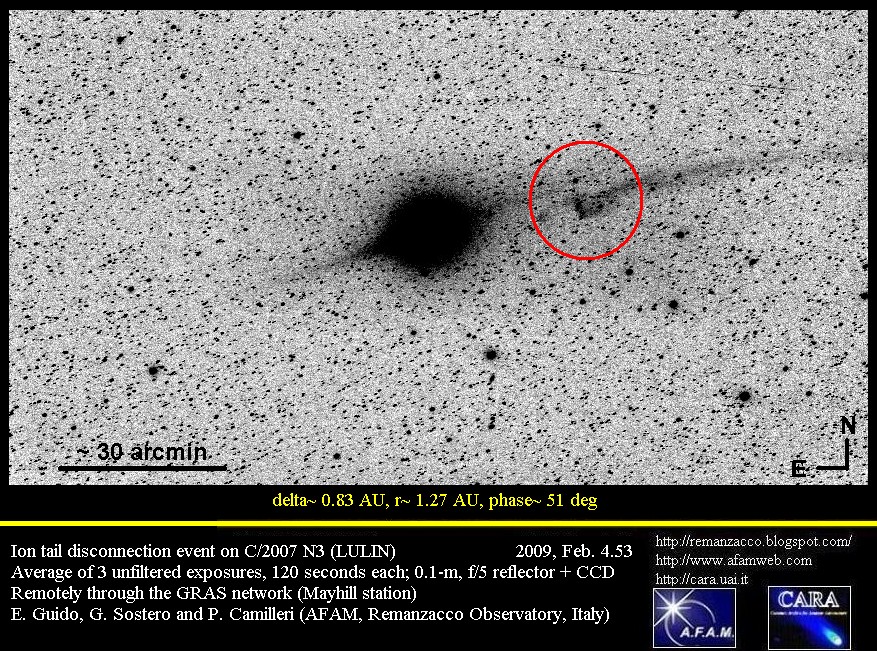
Photo credit: Ernesto Guido, Giovanni
Sostero & Paul Camilleri [more]
Guido and colleagues believe the event was caused
by a magnetic disturbance in the solar wind hitting
the comet. It's a plausible hypothesis. Magnetic
mini-storms in comet tails have been observed
before--most famously in 2007 when NASA's STEREO
spacecraft watched a CME crash into Comet Encke. Encke
lost its tail in
dramatic fashion, much as Comet Lulin did
yesterday.
Comet Lulin Photo Gallery
[3D
orbit] [sky
map] [ephemeris]
|
2-4-09 - No sunspots today:
Current conditions
Solar wind
speed: 364.4 km/sec
density: 14.9 protons/cm3
explanation |
more data
Updated: Today at 1946 UT
X-ray Solar Flares
6-hr max: A0 1940 UT
Feb04
24-hr: A0 1940 UT
Feb04
explanation |
more data
Updated: Today at: 1940 UT
Small, Hot Earth-Like
Planet Discovered
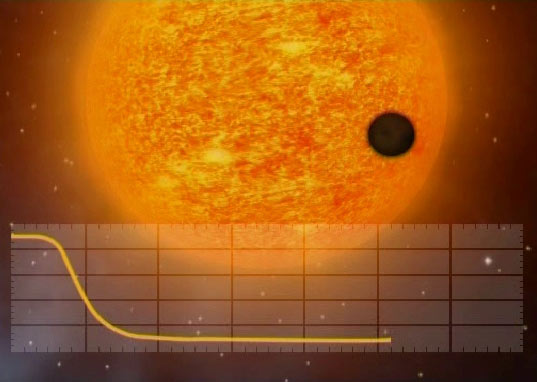
Feb. 3 2009) - What may be the smallest extrasolar
planet, measuring less than twice the size of Earth, has
been discovered orbiting a sun-like star.
The world is far hotter than ours, however. And
controversy over the size claim has heated up, too.
Astronomers using the COROT space telescope
detected a small, hot planet as it transited its
parent star. The planet, described as "rocky"
like Earth, appears as a black dot. "This
discovery is a very important step on the road
to understanding the formation and evolution of
our planet," one astronomer said.
Astronomers used the COROT space telescope (a mission led
by the French Space Agency, and also involving the European
Space Agency and others) to detect the new planet as it
transited its parent star, dimming the light from the star
as it passed in front of it. The host star is located 457
light-years from Earth, where one light-year is the distance
light will travel in a year, or about 6 trillion miles.
"For the first time, we have unambiguously detected a
planet that is 'rocky' in the same sense as our own Earth,"
said Malcolm Fridlund, ESA's COROT Project Scientist. "We
now have to understand this object further to put it into
context, and continue our search for smaller, more
Earth-like objects with COROT."
He added, "This discovery is a very important step on the
road to understanding the formation and evolution of our
planet."
Sara Seager, an astrophysicist at MIT who was not
involved in the discovery said, "My first thought is that
it's extremely exciting because we've been waiting to find a
planet that we can really call rocky. I would just caution
that more information, more data, is needed."
For instance, the discovery has yet to be published in a
peer-reviewed journal, and not much information about the
planet has been released by COROT scientists. Seager says in
order to confirm an exoplanet is rocky, scientists need to
nail down its mass and radius (or the combination of size
and density, or mass and density).
"It looks like the mass is not well-determined and so
that's why they're saying they're not sure what the density
is," Seager told SPACE.com. "They think it is
terrestrial-like. It might have water ice, or it might have
rocks, but it's certainly not a gas giant."
Skip over this content
COROT scientists estimate the planet ranges from 5.7 to
11 Earth masses.
Hot discovery
One big difference in the newfound planet compared to Earth:
COROT-Exo-7b is located very close to its star, orbiting
once every 20 hours. Its temperature is so high, ranging
from 1,832 to 2,732 degrees Fahrenheit that the researchers
say the exoplanet could be covered in lava or water vapor.
The density of the planet is still under investigation,
though scientists say it may be rocky like Earth and covered
in liquid lava. COROT-Exo-7b may also belong to a class of
planets that are thought to be made up of water and rock in
almost equal amounts. Given the high temperatures measured,
the planet would likely be a very hot and humid place.
"Finding such a small planet was not a complete
surprise," said Daniel Rouan, researcher at the Observatoire
de Paris Lesia, who coordinates the project with Alain
Leger, from Institut d'Astrophysique Spatiale. "COROT-Exo-7b
belongs to a class of objects whose existence had been
predicted for some time."
Small and odd
Very few of the more than 300 exoplanets found so far have a
mass comparable to that of Earth and the other terrestrial
planets — Venus, Mars and Mercury. That's because
terrestrial planets are extremely difficult to detect.
Of the Earth-like planets detected, this is the first one
spotted using the so-called transit method, which can yield
both the planet's mass and radius. Other methods just reveal
the planet's mass, Seager said.
The newfound planet's size status is also questioned. When
astronomers study planets, they're interested in both mass
and diameter.
"The claim that it is the 'smallest exoplanet' found to
date is not correct," said planet-formation theorist Alan
Boss of the Carnegie Institution of Washington. "It is the
smallest mass exoplanet found to date that transits, but
other hot super-Earths have been found that do not transit
but have lower masses." Boss was not involved in the current
discovery.
For instance, he adds Gliese 876 d has "a minimum mass of
5.9 Earth masses and a best estimate for the true mass of
7.5 Earth masses."
Most of the methods used so far are indirect and sensitive
to the mass of the planet, which is why bigger worlds are
easier to detect. COROT can directly measure the size of a
planet's surface, which is an advantage to astronomers. In
addition, because the probe is in space, it has longer
periods of uninterrupted observation than from the ground.
The internal structure of COROT-Exo-7b particularly puzzles
scientists, as they are unsure whether it is an "ocean
planet," a kind of planet whose existence has never been
proved so far. In theory, such planets would initially be
covered partially in ice, and they would later drift toward
their star, with the ice melting to cover it in liqu
|
2-3-09 - There are no sunspots today
Current conditions
Solar wind
speed: 311.3 km/sec
density: 2.1 protons/cm3
explanation |
more data
Updated: Today at 1756 UT
X-ray Solar Flares
6-hr max: A0 1755 UT
Feb03
24-hr: A0 0755 UT
Feb03
explanation |
more data
Updated: Today at: 1755 UT
FIREBALL ALERT:
During the next 48 hours, two big pieces of
space debris are expected to re-enter Earth's atmosphere: a 2000
kg Centaur rocket body on Feb. 3rd and a 2500 kg Delta III rocket
body on Feb. 4th. People living along the reentry ground tracks
should be alert for fireballs. Ground tracks:
Centaur,
Delta III.
More fireballs:
Jan. 27,
Jan 23,
Jan 17, 2009;
Dec. 29, 2008
Bottini spots another
comet
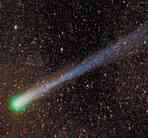
This story is for all those who
want to know more about new space discoveries.
Recently, an Italian astronomer has spotted a comet
from the so-called Jupiter family on the night sky.
Astronomer, Andrea Boattini, who
has already broken a 150-year-old record of spotting
seven comets last year, has now claimed that he
spotted ninth comet last week while scanning currently
visible Near Earth Objects (NEOs).
’I wasn’t too sure it was a comet straight away
because it was hazy but the skies cleared a bit later
and allowed me to confirm the comet’s nature,’’ said
Boattini.
The 39-year-old Italian works at
Arizona’s Mount Lemmon Observatory on a NASA programme
and searches for objects in space that could be
dangerous to our planet, Earth. The new comet has the
technical tag C/2009 B1. However, it is named after
who has discovered it. The comet, which belongs to the
so-called Jupiter family, is in the Andromeda
constellation and bypasses Earth once in every 17
years. Anyone with a medium-sized telescope can
observe the comet until March end.
The comet, which belongs to the so-called Jupiter family,
is in the Andromeda constellation and passes by Earth once in
every 17 years. Anyone with a medium-sized telescope can
observe the comet until March end.
|
2-2-09 No sunspots today
Current conditions
Solar wind
speed: 344.4 km/sec
density: 2.8 protons/cm3
explanation |
more data
Updated: Today at 1756 UT
X-ray Solar Flares
6-hr max: A0 1655 UT
Feb02
24-hr: A0 1655 UT
Feb02
explanation |
more data
Updated: Today at: 1755 UT
|
2-1-09 - No sunspots today
Current conditions
Solar wind
speed: 399.9 km/sec
density: 1.0 protons/cm3
explanation |
more data
Updated: Today at 2345 UT
X-ray Solar Flares
6-hr max: A0 2340 UT
Feb01
24-hr: A0 2340 UT
Feb01
explanation |
more data
Updated: Today at: 2340 UT
COMET LULIN RIGHTENS:
Veteran sky watcher Mariano Ribas of Argentina has
been monitoring Comet Lulin in the skies of Buenos Aires. "In the
past ten days, the comet has brightened by almost 60% (half a
magnitude) to magnitude +6.5," he reports. "Even with our heavy
urban light pollution, the comet is an easy target for small
telescopes and binoculars. Soon, I believe, it will become a
naked-eye object for people in the country."
"My retired eyes
still can't see it," says Jack Newton of Arizona, "but my 14-inch
telescope picked it up quite nicely." He took this picture on Feb.
1st:
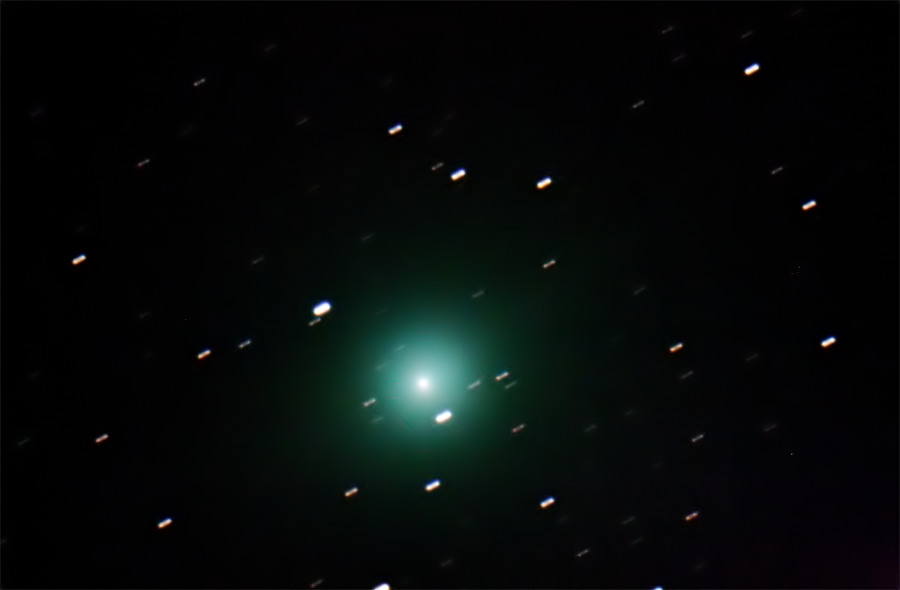
Comet Lulin is approaching Earth for a 38-millon-mile close
encounter on Feb. 24th.
llation Libra. A date of note is Feb. 6th
when the comet passes by double star Zubenelgenubli. Zubenelgenubi
is not only fun to say (zuBEN-el-JA-newbee), but also it
is a handy guide. You can see Zubenelgenubi with your unaided eye
(it is about as bright as stars in the Big Dipper); binoculars
pointed at the binary star reveal Comet Lulin in beautiful
proximity:
sky map.
Comet Lulin Photo Gallery
[Comet
Hunter telescope] [sky
map] [ephemeris]
|
|
SPACE DATABASE ON THIS SITE
DREAMS OF THE GREAT EARTHCHANGES -
MAIN INDEX
| 




















